Exploring the Quality and Value of Amethyst Gemstones
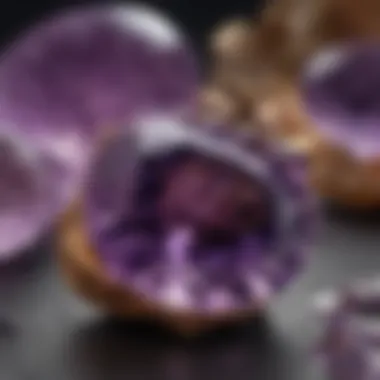
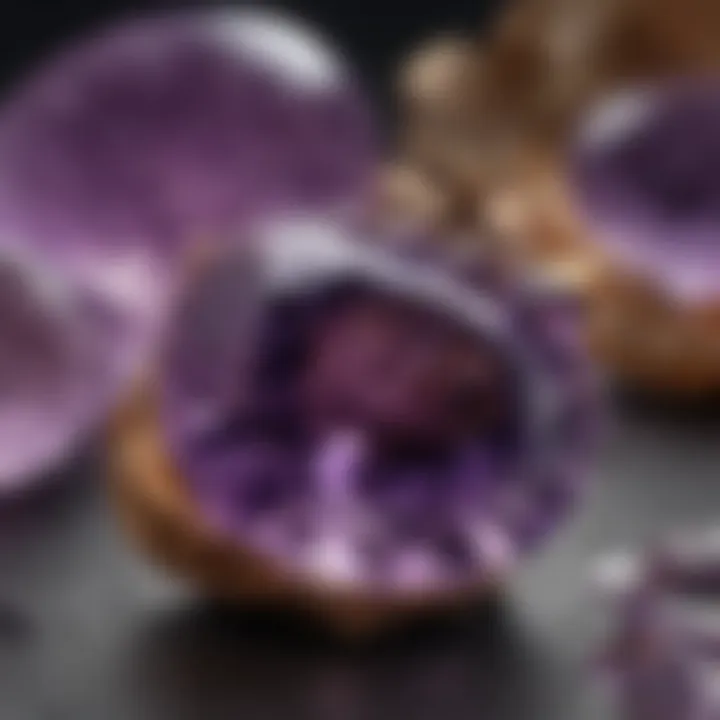
Gemstone Overview
Definition and Characteristics
Amethyst is a beautiful gem that stands out for its mesmerizing violet colors, ranging from light lavender to deep purple. Essentially, it is a variety of quartz that gets its unique hues from the presence of iron and the effects of radiation during its formation. Its vibrant shades often evoke a sense of calm and spirituality, making it a favorite among not just gem enthusiasts but also those interested in holistic healing. The clarity of the stone plays a vital role in how it catches the light, and a well-cut amethyst can truly be a sight to behold.
Amethyst is typically found in geodes, which are hollow rock formations lined with crystals. The geological journey of amethyst, shaped over millions of years, is part of what makes it so special. It’s known for its durability, rating around a 7 on the Mohs scale of hardness. This makes it suitable for various types of jewelry, from elegant rings to stunning necklaces.
Classification of Gemstones
Understanding gemstones can feel a bit like navigating a tangled web. They are categorized based on several characteristics, including their composition, rarity, and treatment processes. In terms of classification, gemstones can be broadly divided into precious and semi-precious categories. Amethyst was once considered a precious stone, alongside diamonds, emeralds, and sapphires. However, the abundance of quality amethyst has shifted it into the semi-precious bracket. Despite this reclassification, its beauty and allure remain undeniable.
- Precious Gemstones: Diamonds, Emeralds, Rubies, Sapphires
- Semi-Precious Gemstones: Amethyst, Topaz, Citrine, Garnet
Historical Significance
Ancient Uses and Cultural Importance
Amethyst has a storied history that transcends cultures. As far back as the ancient Egyptians, this gemstone was used to create amulets intended to protect the wearer and guide their spirit in the afterlife. The Greeks believed that wearing amethyst would ward off intoxication, stemming from the word "amethystos," which translates to "not drunken." This cultural significance reflects a deep reverence for the stone, perceiving it as a bridge between the earthly and spiritual realms.
In various cultures, amethyst is linked to different deities and rituals, symbolizing peace and balance. It is often associated with the intuition and serenity of the mind, making it a go-to stone for meditation practices.
Myths and Legends Surrounding Gemstones
Myths surrounding amethyst are vast and varied, contributing richly to its lore. Among them, one of the most widely recognized tales is that of the Greek god Bacchus. According to legend, Bacchus, angered by a perceived slight, vowed to unleash his tigers on the next person he encountered. That unfortunate soul happened to be a young maiden named Amethyst, who prayed for protection. In response, Artemis, the goddess of the hunt, turned her into a stone. Overwhelmed with guilt, Bacchus poured the juice of grapes over the stone, gifting it the beautiful purple hue we admire today.
“Amethyst is a stone of clarity and tranquility; it resonates with the higher mind.”
— Unknown
Each facet of amethyst tells a story, rich with meaning and significance. From its geological formation to its vibrant place in history, amethyst continues to enchant and inspire those who come into contact with it.
Understanding Amethyst
Amethyst holds a remarkable place in the pantheon of gemstones. It is not just admired for its stunning purple hues but also revered for its intricate attributes that influence its quality, desirability, and overall value. By delving into amethyst’s definition, composition, and cultural significance, one begins to uncover layers of meaning behind this captivating stone.
Definition and Composition
Amethyst is a striking violet variety of the mineral quartz, a common component of various rocks. Its color arises primarily from the presence of iron impurities combined with natural irradiation, causing unique hues that range from a light lavender to a deep, royal purple.
What makes it unique? The ideal amethyst is often categorized based on its color intensity and tone. To put it simply, a high-quality amethyst displays a rich, saturated purple with little to no color zoning.
The chemical formula for amethyst is SiO₂ (silicon dioxide), which is the same as that of quartz. However, its allure comes from its trace elements, particularly iron and aluminum, and the conditions under which it forms. You might say that amethyst is like a personality: it has different shades and aspects that contribute to its overall character.
Historical Significance
Throughout the ages, amethyst has captured the hearts and imaginations of cultures across the globe. Ancient Egyptians cherished it, believing it to be a protective stone that enhanced intuition. The Greeks, too, held the belief that it could ward off drunkenness, often crafting wine goblets from the stone. Such myths and legends tie closely to its historical significance.
For centuries, it has graced the crowns of royalty and adorned the vestments of the clergy. The stone was once deemed more valuable than diamonds in the Medieval period—an indication of its high status and appeal. Interestingly, the transition of amethyst from a precious gem to a more common one is due to large deposits found in Brazil during the 19th century. This shift has led to a re-evaluation of its market value, yet its historical charm remains potent for collectors and enthusiasts alike.
Cultural Associations
Culturally, amethyst embodies a wealth of symbolism and meanings. In various traditions, it is associated with clarity of thought, balance, and spiritual grounding. Often seen as a stone of tranquility and healing, it is believed to support emotional stability, making it popular among holistic healers and gemstone enthusiasts.
"Amethyst promotes inner peace and a calm disposition, encouraging a sense of well-being in the wearer."
The stone also finds its way into various religious artifacts and ceremonies, from Buddhist practices to Christian symbols. In the modern context, amethyst is frequently used in jewelry design, enhancing the beauty of pendants, rings, and bracelets, while keeping its ancient ties intact.
Understanding amethyst is more than just knowledge about a pretty stone; it is about grasping its historical weight, cultural resonance, and the nuances that collectively shape its quality. In an industry where authenticity and quality are paramount, having a firm grasp on these aspects of amethyst can elevate both the appreciation and investment in this exquisite gemstone.
Grading Amethyst Quality
Understanding how to evaluate the quality of amethyst is crucial for both collectors and enthusiasts. Grading amethyst quality goes beyond the mere aesthetics; it highlights the fundamentals of what makes this stone valuable. The factors involved can significantly influence the price, desirability, and overall appeal of the stone. Knowing these identifiers not only aids in purchasing decisions but also enhances one’s appreciation of amethyst as a gemstone.
Color: The Most Crucial Factor
When it comes to assessing the quality of amethyst, color is king. With amethyst, the color can range from a pale lavender to a deep, rich purple. Vivid color is often associated with higher quality stones and is highly sought after in the gem market.


Shades and Variants
Every stone tells a story, and the shades of amethyst are a big part of that narrative. Variants of amethyst can have different undertones, such as reddish or bluish hues. These shades can dramatically affect how the stone is perceived. A warm purple might evoke feelings of coziness, while a cooler tone can appear more regal.
A key characteristic of these shades is how they interact with light—some colors will gleam beautifully while others may look more muted. This can sway buyers toward certain variants, especially those that display a desirable depth of color. However, finding the perfect shade can be a challenge, as everyone has personal preferences about what they find appealing.
Color Saturation
Closely related to the hue is saturation, which determines how intense the color appears. Highly saturated amethyst stones, where the color is both deep and vivid, tend to draw more attention. This intensity not only pleases the eye but also signals quality.
Saturation's unique feature lies in its capacity to enhance the visual appeal of the stone, providing an almost glowing presence. A well-saturated amethyst stands out remarkably in jewelry designs, despite being considerably more expensive. However, one downside is that overly saturated stones may tend to obscure subtle undertones found in lighter variants, which can be a drawback for collectors who seek a broader visual spectrum.
Clarity and Transparency
Clarity is another essential aspect when grading amethyst. Generally, a clear stone is more desirable than one with noticeable flaws.
Internal Inclusions
Inclusions or "imperfections" can tell a lot about a stone's journey. These internal features may appear as tiny spots or streaks trapped within the amethyst during its formation. While they can diminish the clarity, they also add character, representing the natural story of the gem. Some collectors appreciate these inclusions for their unique story, while others prefer pristine stones without any marks. Thus, their presence can sway buyer preferences, reflecting either a sense of rarity or a plain flaw.
Surface Flaws
Surface flaws, discrepancies found externally, can equally affect a gemstone’s overall quality perception. These may be tiny scratches or chips that can catch the light in ways that distort the stone's beauty. A piece with few surface flaws will certainly fetch a better price on the market, as buyers often view them as more elegant and fit for fine jewelry.
The unique factor about surface flaws is that they can be polished away, but that adds additional costs. Therefore, potential buyers should weigh the benefits of a perfect finish against the price before committing to a purchase.
Cut and Shape
The way an amethyst is cut can improve or diminish its appearance dramatically. Therefore, understanding popular cuts and their respective shapes can make a world of difference.
Popular Cuts
Various cuts can enhance the beauty and brilliance of amethyst. The standard cuts, like round, oval, and emerald, have their own appeal, but designers often explore innovative cuts to showcase the crystal's unique features. The key characteristic of these cuts lies in how they expand light interaction, impacting sparkle and visual depth. More intricate cuts might attract attention for their artistry; however, they also pose risks if not done correctly.
Proportions and Symmetry
Another crucial aspect of amethyst's quality lies in its proportions and symmetry. A well-cut stone will maintain balance in dimensions, resulting in visual harmony that can be quite appealing. The most prized cuts carefully adhere to guidelines that ensure the stone doesn’t look awkward or lopsided. This is essential for both aesthetic reasons and optimal light performance. The downside, though, is that getting it just right can become costly, as not all jewelers possess the needed skill.
Carat Weight and Size
Finally, there’s the matter of carat weight and size. Larger amethysts can fetch higher prices, but size doesn’t always equate to quality. It’s vital to consider how the other grading criteria integrate with size to understand a stone’s real value.
A heavier amethyst can be striking in a statement piece, however, smaller, more intense stones may resonate better for some collectors. Thus, carat weight is essential but is often viewed in conjunction with the gemstone's other attributes, affecting what people are willing to pay.
Geological Formation of Amethyst
Understanding the geological formation of amethyst provides valuable insight into its quality and rarity. This section delves into how amethyst forms, the specific environments that foster its creation, and the geographical sources where it is found. These elements are crucial in appreciating not only the beauty but also the intrinsic value of this gemstone.
Crystallization Processes
Amethyst is formed through a fascinating process known as crystallization, which occurs within volcanic rocks, particularly in the cavities of basalt. As hot, mineral-rich water seeps into these cavities, it cools down slowly over time. During this cooling period, silicon dioxide crystallizes, eventually forming the beautiful purple quartz we recognize as amethyst.
While the base crystalline structure is uniform, the specific hues of purple and lavender arise from the presence of iron impurities and natural radiation exposure. These factors can significantly affect the gem’s aesthetic appeal, making understanding the crystallization process a crucial aspect of assessing amethyst quality.
Geographic Sources
When considering where the finest amethyst originates, certain regions have become well-known for their particularly striking specimens. Each geographic source offers unique characteristics that contribute to their desirability.
Brazil
Brazil, often heralded as the leading producer of amethyst, offers a stunning variety of colors and sizes. The state of Rio Grande do Sul is particularly famous for its rich deposits. The most notable aspect of Brazilian amethyst is its strong saturation and large crystals, which can be several centimeters in size.
One of the benefits of Brazilian amethyst is its widespread availability and durability, making it a popular choice among jewelers and collectors alike. However, the sheer volume of amethyst produced can sometimes dilute the perceived uniqueness of Brazilian stones; as a result, discerning buyers might seek more exclusive alternatives.
Uruguay
Next up, Uruguay presents another unique flavor in the amethyst world. Known for producing some of the finest quality amethyst, Uruguayan stones display deep, rich colors, often with a striking translucency that catches the eye. The specific mines in Artigas and Paysandu have become synonymous with high-quality amethyst.
What sets Uruguay apart is the smaller size of the crystals compared to those from Brazil, but they are notable for their exceptional clarity and vibrant color saturation. Collectors and jewelry makers tend to prize Uruguayan amethyst for its rarity and visual appeal, which can command higher market prices compared to other geographies. On the downside, their limited supply means that they can be a bit harder to find.
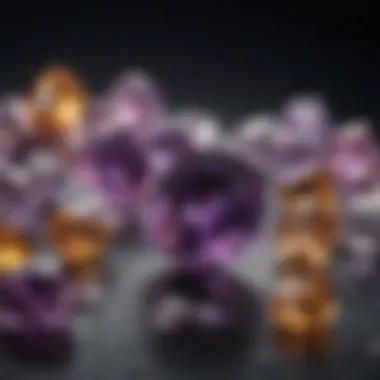
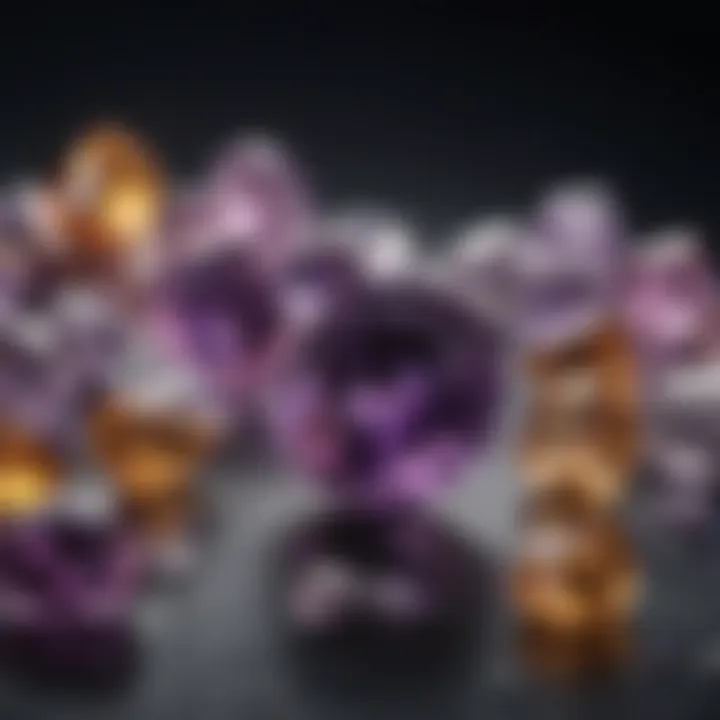
Zambia
Zambia has recently gained attention as a significant source of amethyst. The Zambian amethyst is often characterized by its striking deep purple hues, which are attributed to higher iron content compared to its South American counterparts. The Kafubu area is particularly notable for producing these vibrant stones.
Zambia's amethyst is recognized for its incredible color and clarity, appealing to high-end jewelers and gemstone enthusiasts. However, being a newer player in the market compared to Brazil or Uruguay, Zambian amethyst could still be in the shadow in terms of widespread recognition. Yet, its unique characteristics could offer an exciting option for those looking to invest in a distinct stone.
In summary, the geological formation of amethyst plays a significant role in its overall quality. From the crystallization processes to the unique characteristics found in Brazil, Uruguay, and Zambia, each of these elements helps shape the amethyst that enthusiasts, collectors, and jewelry designers cherish today.
Market Trends and Valuation
The world of amethyst isn’t just about its vibrant hues and historical significance; it also reflects a dynamic marketplace that intertwines demand, rarity, and valuation. Understanding market trends and how valuation operates can give both collectors and enthusiasts a leg up when navigating their way through purchases or investments related to amethyst.
Many factors come into play when considering how amethyst is valued. From the geological sources where it's mined to the rising trends in jewelry and décor designs that favor unique gemstone pieces, the market for amethyst pulses with ever-changing dynamics. This section unfolds the importance of this aspect in the broader narrative of quality analysis.
Current Market Evaluation
At present, the market for amethyst has shown a gradual yet steady rise, largely influenced by its increasing popularity in jewelry design and home decor. With the rising interest in sustainable luxury, many buyers turn towards gemstones known for their aesthetic beauty and spiritual properties. Market data indicates that:
- The global demand for amethyst has been fueled by an influx of designers incorporating it into modern pieces.
- Online platforms have widened the reach of buyers and sellers, increasing competition and variety.
- Amethyst is often marketed not only as a gemstone but also as a metaphysical stone, tapping into wellness trends.
This combination has propelled its price upward, yet it remains more accessible compared to other gemstones, making it an attractive option for beginners in the gemstone collecting community.
Influence of Rarity on Price
Rarity is a significant determinant in the valuation of amethyst. While it's plentiful compared to other gemstones, certain shades and sizes are harder to come by. For instance, deep, saturated purple amethysts with fewer inclusions are highly sought after. It’s like finding a needle in a haystack.
Considerations regarding rarity include:
- Geographic Origins: Amethyst from specific regions, such as the districts of Brazil or Uruguay, often fetch a higher price because of their distinct quality and history.
- Color Quality: Amethysts that exhibit more vivid colors tend to command higher prices, while those that are too pale or too dark might see their values drop.
- Size: Larger stones are rarer, but they can be a double-edged sword; they must exhibit superb quality to reach their full potential market price.
"The finer the amethyst, the higher the value. But value swings can often depend on current trends in the market, making timing crucial for buyers and sellers alike."
Investment Potential
Amethyst may not wear the crown of a traditional investment, but it certainly offers a compelling case for collectors and investors alike. As it holds intrinsic beauty along with metaphysical beliefs, it has gained traction as an alternative investment. However, like any investment in tangible assets, potential buyers should keep a few things in mind:
- Market Fluctuations: Prices can vary widely depending on seasonal trends and consumer interest, where sometimes a particular shade can shift in desirability rapidly.
- Long-Term Value: While immediate sales may fluctuate, high-quality amethysts can appreciate significantly over time, especially if held for years.
- Emerging Markets: Countries like China and India are increasingly participating in the gemstone market, which could introduce new buyers and consequently, drive up demand.
When considering amethyst as an investment, research, understanding the nuances of grading, and current market indicators are essential. For gemstone enthusiasts looking to broaden their portfolios, investing in high-quality amethyst could be a savvy move given its potential for both appreciation and personal enjoyment.
Caring for Amethyst
Taking proper care of amethyst is crucial for maintaining its beauty and preserving its value. Amethyst can be a stunning addition to collection or jewelry, but its longevity depends significantly on how it is cared for. Thanks to its rich colors and historical significance, understanding how to properly maintain amethyst is important for both collectors and enthusiasts alike.
Cleaning Techniques
Cleaning amethyst requires a delicate touch. When you have a piece of amethyst, whether it’s a raw crystal or set in a piece of jewelry, it’s essential to clean it properly to avoid damage. Here are some techniques that can be used:
- Warm Soapy Water: For most amethyst jewelry, a gentle wash with warm, soapy water is safe. Use a soft cloth or a soft-bristle toothbrush to remove dirt and grime. Rinse well afterwards to ensure no soap residue remains.
- Avoid Harsh Chemicals: Chemicals can discolor or even damage the stone. It's best to steer clear of these when cleaning. If in doubt, stick to good old soap.
- Steam Cleaning: This method is effective, but only for jewelry without delicate settings. Steam can clean nooks and crannies but can also dislodge stones if not done carefully.
Keeping your amethyst clean can seem like a chore, but it's worth the trouble to maintain its vibrant appearance.
Storage Recommendations
Not all storage solutions are created equally, especially when it comes to amethyst. Proper storage protects against scratches, chips, and fading from light exposure. Here’s how to do it right:
- Separate from Other Gemstones: To prevent scratches, store amethyst away from harder stones. A simple cloth pouch or a dedicated compartment in a jewelry box can do the trick.
- Avoid Direct Sunlight: Prolonged exposure to sunlight can fade the stone. A cool, dark area is ideal for storing amethyst.
- Use Boxes with Dividers: If you have several pieces, consider a jewelry box with dividers to prevent them from touching each other, thus avoiding potential scratches.
Taking the time to store amethyst properly can save you from future headaches related to damage or fading.
Preventing Damage
Damage can come in many forms, from physical impacts to environmental factors. Here are some tried-and-true ways to guard your precious amethyst:
- Limit Exposure to Heat: Extreme temperatures can damage the stone. Keeping it away from fireplaces, heaters, or direct sunlight is crucial.
- Be Mindful During Wear: If you’re wearing amethyst jewelry, be cautious in settings like gyms or while engaging in activities where the stone might get bumped or scratched. Take off your jewelry when doing heavy work or sports.
- Regularly Inspect Your Pieces: Always check for loose settings or signs of wear. Spotting potential issues early can save a piece from being lost completely.
This careful vigilance in handling amethyst helps prolong its life and keeps it looking as splendid as the day you acquired it.
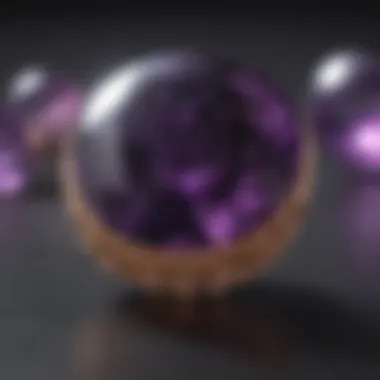
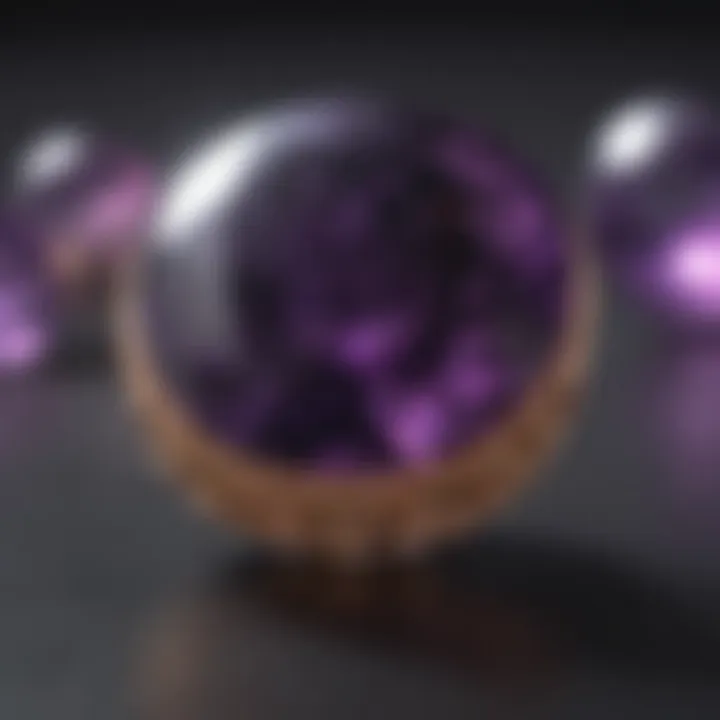
"A little care goes a long way in preserving the beauty of your gemstones, and amethyst is no exception."
Amethyst in Modern Jewelry
Amethyst, with its serene and enchanting violet hues, plays a pivotal role in today's jewelry landscape. Not just a pretty stone, amethyst has inherent qualities that make it a favored choice among designers and consumers alike. Its vibrant colors, range in shades, and deep cultural significance underscore why amethyst isn't merely an accessory but a statement of personality and taste. Modern jewelry often sets the stage for expressions of individuality, and amethyst fits seamlessly into these narratives.
Design Trends
When it comes to design trends, amethyst offers versatility that appeals to both minimalist and extravagant styles. One trend that has gained traction in recent years is the incorporation of raw or geode-like amethyst crystals in jewelry pieces, giving a nod to nature's unrefined beauty. This approach highlights the stone's natural formations and often results in one-of-a-kind items, which are a breath of fresh air compared to more traditional polished designs.
Another popular direction in the jewelry realm involves the use of amethyst paired with complementary stones. For instance, pairing it with diamonds can create a striking contrast, while mixing it with rose gold or silver enhances its elegance. This combination not only amplifies the visual appeal but also broadens the wardrobe possibilities for those who cherish these gems.
The rise of sustainable fashion has also influenced how amethyst is used. Consumers lean towards ethically-sourced stones, spurring designers to explore eco-friendly approaches and supply chains that ensure transparency. This shift in values not only promotes responsible sourcing but also rejuvenates age-old craftsmanship techniques that honor the gemstone's rich history.
Setting Techniques
The setting of amethyst in jewelry is as critical as its design. Different setting techniques can dramatically change the overall aesthetic and natural renditions of the stone. Among the most popular techniques is the prong setting, which allows light to pass through the stone, accentuating its brilliance and color saturation. This is a favorite choice for rings, showcasing the stone’s depth effectively.
Conversely, the bezel setting encases the stone entirely, providing a modern feel while ensuring robust protection against potential damage. This method is particularly appealing for pendants and bracelets, creating a sleek profile that enhances the stone's visual impact without overshadowing its natural beauty.
In addition to these, there are more elaborate designs like the pavé setting, where tiny stones surround the main amethyst, creating a dazzling effect that catches the eye. It’s a way of incorporating amethyst into statement pieces that speak volumes without being overbearing.
Each decision about the setting is a blend of functional considerations and artistic expression, reflecting personal tastes and the evolving trends of jewelry makers.
"In the realm of gemstones, how a stone is set can define its character as much as its color."
The continued popularity of amethyst in modern jewelry showcases not only its aesthetic value but also the deep-seated connection people have with this remarkable gemstone. As trends evolve, so does the creative dialogue surrounding amethyst, ensuring that it remains a cherished choice for generations.
For anyone looking into the world of gemstones, especially amethyst, staying abreast of these trends and techniques is essential for making informed and stylish choices.
Metaphysical Properties of Amethyst
Amethyst, beyond its striking beauty and position in the gemstone hierarchy, is imbued with a rich tapestry of metaphysical properties. Those who delve into the realms of crystals often reference amethyst not merely as a visual delight but as a vessel of spiritual significance. Historically and contemporarily, the stone is believed to carry profound benefits for those who include it in their lives — serving as a bridge between the natural world and ethereal realms.
Historical Beliefs
Delving into the annals of history reveals a wealth of beliefs surrounding amethyst. Ancient cultures such as the Greeks considered the stone a symbol of clarity and balance. They believed that amethyst could ward off intoxication, both literally and metaphorically. The term "amethyst" itself is derived from the Greek word "amethystos," meaning "not drunken." This connection indicates a long-standing association with sobriety and clear thinking.
In the Middle Ages, clergy often wore amethyst in their religious regalia, reinforcing its perceived purity and power. It was believed to promote calmness and wisdom, aiding in the decision-making process — an aspect that still resonates with many spirituality seekers today. The stone also found its place in various cultures as a talisman against negative energies, allowing its owners to navigate life’s challenges with greater fortitude.
"Amethyst has been revered across cultures, offering protection, clarity, and peace to its bearers throughout history."
Contemporary Uses
Today, amethyst continues to find itself integrated into modern healing practices. Many enthusiasts, from crystal healers to wellness advocate, recognize its purported properties in enhancing intuition, promoting peace, and assisting in meditation. It's not uncommon to find amethyst being utilized in various holistic practices. Here are some of its contemporary uses:
- Meditation Aid: Used during meditation practices, many individuals find it helps them to achieve a deeper state of relaxation.
- Sleep Enhancer: Placing amethyst under a pillow is often recommended for those dealing with insomnia, as it is thought to foster a restful ambiance.
- Energy Cleansing: Amethyst is frequently placed in spaces to negate unwanted energies, enhancing the overall vibrational quality of the environment.
- Jewelry: Beyond aesthetics, wearing amethyst jewelry is a common practice, with many believe it brings both protection and clarity to the wearer's thoughts.
These properties make amethyst a versatile crystal, appealing to a wide audience, from collectors to those simply looking to enhance their well-being. With its historical roots and evolving applications, the allure of amethyst shines brighter than ever, making it a cornerstone in the study and practice of metaphysical properties.
Culmination: The Enduring Appeal of Amethyst
Amethyst’s enduring allure is not just a matter of its stunning colors and forms; it embodies a rich tapestry of historical, cultural, and metaphysical significance. This article has journeyed through the many layers that compose the identity of this remarkable gemstone, leaving us with a deeper understanding of why amethyst continues to captivate hearts and minds.
Significance of Quality in Amethyst
Quality is the cornerstone of desirability in any gemstone, and amethyst is no exception. The criteria for grading—like color, clarity, cut, and carat weight—play a crucial role in determining both its natural beauty and its market value. By knowing what to look for, enthusiasts gain confidence in their choices, whether they are purchasing a piece of jewelry or adding to a collection.
Amethyst, with its mesmerizing shades of purple and violet, embodies a quality continuum. Rare, highly saturated colors command attention and often fetch higher prices, while transparency and clarity further enhance aesthetic appeal. Understanding these facets ensures that buyers are informed and equipped to make savvy choices in what is an ever-evolving market.
Cultural Resonance and Historical Context
Amethyst has transcended time and cultures, often associated with royalty and spiritual wellness throughout history. From ancient Egypt to modern-day jewelry design, its rich lore and diverse symbolism contribute significantly to its appeal. Amethyst was once considered a precious stone, highly valued by the elite and revered for its supposed protective properties.
The cultural associations attached to amethyst are rich and varied. For instance, in many traditions, it’s believed to promote calmness and clarity, making it a favorite among those seeking balance in a chaotic world. This aspect enhances its status not just as a gemstone but as a medium through which personal expression is channeled.
Practical Considerations for Appreciation
Caring for amethyst includes practical advice that is vital for preserving its beauty. The guidelines on cleaning and storage discussed throughout the article are crucial, especially for collectors who may have personal or financial investments in these stones. Preventing damage ensures that the inherent qualities remain intact, allowing the full essence of the amethyst to shine through over time.
"Understanding how to care for amethyst not only preserves its physical beauty but also honors the cultural legacy behind it."
Final Thoughts
The continuous evolvement of market trends serves to reinforce the gem’s significance while inviting new generations to explore its charm. As amethyst retains its standing as a popular choice, every piece tells a unique story, reflecting a particular moment in time for both the stone and its bearer. Whether for investment or personal adornment, amethyst remains a captivating subject—ever worthy of exploration.







